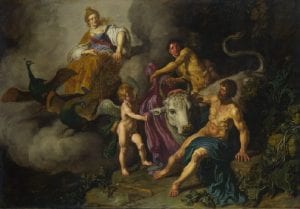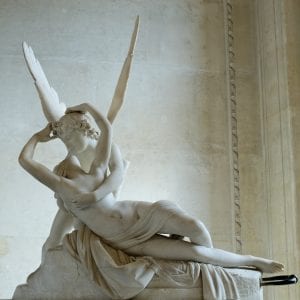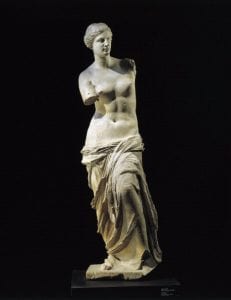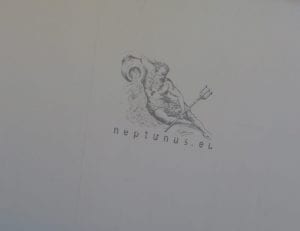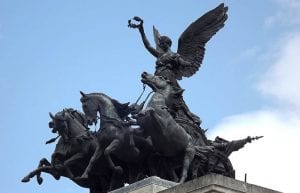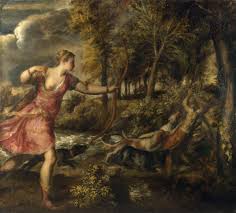Eros, better known by his Roman counterpart’s name Cupid, is one of the most recognizable figures in Greek mythology. He is commonly known as a symbol for Valentine’s Day. He is the winged god of love and desire. Throughout history, there have been several different versions describing Eros’ origins. One of Eros’ origin stories not only makes him a primordial god, but also one of the oldest. He is presented as the son of Chaos, the representation of the emptiness that was, before anything existed. In this version he is either self-formed or is born out of an egg Nyx (Night) laid. Either way, he emerges from Chaos and becomes the generator of life. This initial telling
“Version” WOULD BE MORE TECHNICALLY ADEQUATE
is important because in later versions he is depicted as the son of Aphrodite and is treated as more of a minion or companion, than a great primordial god that preceded other gods. This later version is also the one that is more commonly referred to when talking about Eros. Eros is an extremely important figure in Greek mythology and is much more than a mischievous god with a magical bow and arrow. In fact, he often acts as a catalyst for the events that unfold in various key stories.
The role Eros plays as a god is an interesting one. He uses arrows to manipulate humans and even other gods to the power of love. Love is often portrayed as the great equalizer amongst gods and humans alike by great writers such as Ovid was Eros’ to control,
<< SYNTAX FAULTY
Eros is often depicted with a bow and arrow, which he uses to make people fall in or be indifferent to love. He uses two kinds of arrows. He uses golden arrows that sparks love and dull weighted arrows full of lead that causes the victim to be disinclined with a lover.
PLEASE BE AWARE THAT THE IDEA OF EROS’ TWO DIFFERENT ARROWS WITH DIFFERENT EFFECTS IS ONLY LATE
Eros’ powers represent love and lack of interest alike.
<<WHAT SAID ABOVE ALSO APPLIES TO THIS POINT
I think he is such a popular figure because of how humans relate to love. We see that although he is a god and not just a personification like other mythological figures, he is the embodiment of love and desire. Eros although a singular deity, was part of Aphrodite’s band of winged love gods that were named after him, the “Erotes.”
PLEASE REMEMBER THAT THE PROLIFERATION OF THE “EROTES” MAY APPEAR ALREADY IN ARCHAIC ANACREON, BUT ITS STANDARDIZATION IS ONLY VERY LATE
These were gods of different kinds of love and desire. For example the god Anteros is the god of “requited love” and the god Himero is the god of “pressing desire”. Out of all the Erotes, Eros is the most referred to.
WHAT DO YOU MEAN? DO YOU MEAN THAT AT LEAST IN TE ARCHIC AND CLASSICAL AGE OF GREEK CULTURE “EROTES” ARE NOT OFTEN MENTIONED, AND ALMOST ONLY EROS IS ?
Juno discovering Jupiter with Io (1618) by Pieter Lastman
Cupid (Eros) can be found drawn in the background of many famous illustrations that depict mythological stories. In the image displayed above Pieter Lastman depicts the scene in which Juno (Hera) discovering Jupiter (Zeus) with the cow Io.
<< SYNTAX FAULTY.NO FINITE VERB!
This is an image that came up several times throughout the duration of this course. It is a painting that is held at The National Gallery here in London which I got to see how detailed it was up close. Although this image is a drawing of a scene in one of the stories from Ovid’s poem Metamorphoses in which only Juno, Jupiter, and Io are present Lastman painted in Cupid and a man wearing a mask. It is unknown whether Cupid and the masked man are trying to cover up the heifer Io and Jupiter from Juno or unveiling the adulterers. Whether or not the or
SYNTAX FAULTY
covering or uncovering the lovers it is important to note Cupid’s presence. This is an example of Cupid being used
PLEASE ADD: “to”
personify love with the masked man being used to personify deceit. In this story Jupiter’s desire for Io not only causes him to cheat on Juno like he’s done several times before, but to turn her into a heifer and engage in intercourse while she’s in that form. Juno is known for being unfaithful to Juno and it is often blamed on Cupid. He is vital to Greek mythology because he has the power to humanize the gods in lighter and more comedic representations of their stories using the power of love.
Psyche Revived by Cupid’s Kiss (1787-1793) by Antonio Canova
Sculpture was another medium in which Eros (Cupid) was commonly depicted in. However, there are several differences between the way Eros (Cupid) is being depicted in Lastman’s painting and Antonio Canova’s sculpture other than the fact that they used two different artistic mediums. Initially he was portrayed by artists as a very handsome young man, but over the years he started being characterized as a mischievous child. In Lastman’s painting he is shown as the later. Whereas, Conova’s
“Canova”
sculpture represents him as a young man. This sculpture is important, because it is depicts a scene from Cupid and Psyche. Although in most important mythological stories Eros plays a background character causing mischief by making humans and gods alike fall in love, The Golden Ass by Apuleius tells a story in which he’s the protagonist. In this story even he is not immune to the power of his own arrows. After being sent to humiliate Psyche by Venus because men started worshipping her, Cupid could not do it and instead pricked himself with his own arrow. Cupid although characterized as mischievous was a loyal and obedient servant to his mother. This story is important because strays from that narrative.
I WOULD WRITE “role-standard” NOT “narrative”
Not only is Eros an important figure in mythological cannon,
“canon”
but his role in symbolizing love and desire is something many people including myself can relate to. He is much more than the cherub resembling Cupid we associate with Valentine’s day and love.
Works Cited
Britannica, The Editors of Encyclopaedia. “Eros.” Encyclopædia Britannica, Encyclopædia Britannica, Inc., 15 Feb. 2018, www.britannica.com/topic/Eros-Greek-god.
“PHANES.” IRENE (Eirene) – Greek Goddess Hora of Peace (Roman Pax), www.theoi.com/Protogenos/Phanes.html.
“The God Eros in Greek Mythology.” Greek Legends and Myths, www.greeklegendsandmyths.com/eros.html.
